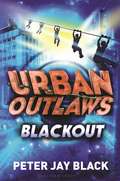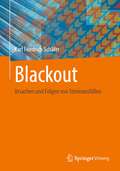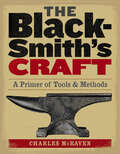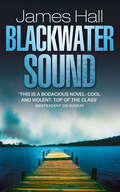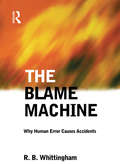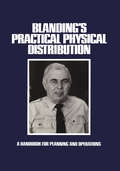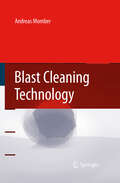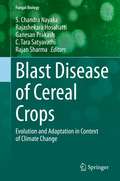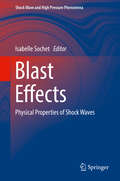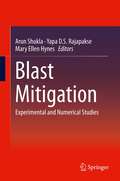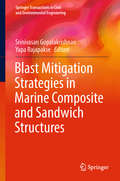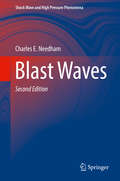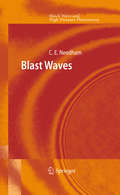- Table View
- List View
Blackout (Urban Outlaws #2)
by Peter Jay BlackThe world's most lethal computer virus has been unleashed into cyberspace, and now the Urban Outlaws-five tough kids dedicated to justice-must destroy it. Leader Jack knows that they have to shut it down before it throws the world into chaos. But how can he find a virus that might be anywhere, and everywhere?Then the team meets Hector, an insanely talented hacker who even impresses Jack. The Urban Outlaws need his help, but can they trust him? It's a risk that could mean winning big, or losing everything. . . . This sensational sequel has all the makings of a blockbuster movie: non-stop action, cutting edge technology, and a high-stakes plot. But at the heart of this thrill ride is the story of five gutsy kids who will do anything to save the world-and protect each other.
Blackout: Ursachen und Folgen von Stromausfällen
by Karl Friedrich SchäferDieses Buch beschreibt die unterschiedlichen Ursachen, aus denen sich Blackouts entwickeln können, sowie die technischen, wirtschaftlichen und sozialen Folgen in den verschiedenen Bereichen der kritischen Infrastrukturen bei länger andauernden Unterbrechungen der Stromversorgung. Anhand eines exemplarischen Ablaufs werden die zeitlich gestaffelten Ereignisse skizziert, die aufgrund eines Blackouts auftreten. Die Ursachen, der Ablauf und die Auswirkungen von Blackouts, die sich in den letzten Jahren ereignet haben, sind ebenfalls Bestandteil dieses Buches. Abschließend werden Maßnahmen zur Vermeidung von Blackouts sowie die Abläufe zum Wiederaufbau des Energieversorgungssystems beschrieben.
The Blacksmith's Craft: A Primer of Tools & Methods
by Charles McRavenCharles McRaven guides you through the process of building a forge from recycled materials, acquiring tools, and learning basic blacksmithing techniques.
Blackwater Sound (Thorn Ser. #4)
by James HallCompelling action and suspense in the Florida Keys and Bahamas – in the atmospheric new thriller from a writer acclaimed by Dennis Lehane, Michael Connelly and Robert Crais.
Blackwell's Concise Encyclopedia of Environmental Management
by Peter P. CalowDrawing on entries from The Encyclopedia of Ecology and Environmental Management, this concise reference will provide an essential quick guide for those working in the field of environmental management: consultants, planners, environmental advisors in industry, and students. Approximately 1500 key terms are defined in language that can easily be understood by the non-expert. Key acronyms, socio/economic terms, and scientific terms are all discussed. Over 1500 key terms Avoids technical jargon Includes key acronyms
Blade Element Rotor Theory
by Pylyp VolodinBlade Element Rotor Theory This book presents an extension of the conventional blade element rotor theory to describe the dynamic properties of helicopter rotors. The presented theory focuses on the accurate mathematical determination of the forces and moments by which a rotor affects its rotorcraft at specified flight conditions and control positions. Analyzing the impact of a blade's non-uniform properties, the book covers blade twisting, the non-rectangular planform shape of a blade, and inhomogeneous airfoil along the blade. It discusses inhomogeneous induced airflow around a rotor disc in terms of the blade element rotor theory. This book also considers the impact of flapping hinge offset on the rotor's dynamic properties. Features • Focuses on a comprehensive description and accurate determination of the rotor's aerodynamic properties • Presents precise helicopter rotor properties with inhomogeneous aerodynamic properties of rotor blades • Considers inhomogeneous distribution of induced flow • Discusses a mathematical model of a main helicopter rotor for a helicopter flight simulator This book is intended for graduate students and researchers studying rotor dynamics and helicopter flight dynamics
Blade Element Rotor Theory
by Pylyp VolodinBlade Element Rotor Theory This book presents an extension of the conventional blade element rotor theory to describe the dynamic properties of helicopter rotors. The presented theory focuses on the accurate mathematical determination of the forces and moments by which a rotor affects its rotorcraft at specified flight conditions and control positions. Analyzing the impact of a blade's non-uniform properties, the book covers blade twisting, the non-rectangular planform shape of a blade, and inhomogeneous airfoil along the blade. It discusses inhomogeneous induced airflow around a rotor disc in terms of the blade element rotor theory. This book also considers the impact of flapping hinge offset on the rotor's dynamic properties. Features • Focuses on a comprehensive description and accurate determination of the rotor's aerodynamic properties • Presents precise helicopter rotor properties with inhomogeneous aerodynamic properties of rotor blades • Considers inhomogeneous distribution of induced flow • Discusses a mathematical model of a main helicopter rotor for a helicopter flight simulator This book is intended for graduate students and researchers studying rotor dynamics and helicopter flight dynamics
Blade-Pitch Control for Wind Turbine Load Reductions (Springer Theses)
by Wai Hou LioThis thesis investigates the use of blade-pitch control and real-time wind measurements to reduce the structural loads on the rotors and blades of wind turbines. The first part of the thesis studies the main similarities between the various classes of current blade-pitch control strategies, which have to date remained overlooked by mainstream literature. It also investigates the feasibility of an estimator design that extracts the turbine tower motion signal from the blade load measurements. In turn, the second part of the thesis proposes a novel model predictive control layer in the control architecture that enables an existing controller to incorporate the upcoming wind information and constraint-handling features. This thesis provides essential clarifications of and systematic design guidelines for these topics, which can benefit the design of wind turbines and, it is hoped, inspire the development of more innovative mechanical load-reduction solutions in the field of wind energy.
Blake's Design of Mechanical Joints (Mechanical Engineering)
by Harold Josephs Ronald L. HustonBlake's Design of Mechanical Joints, Second Edition, is an updated revision of Alexander Blake’s authoritative book on mechanical joint and fastener design. This revision brings Blake’s 1985 volume up-to-date with modern developments in joint design, and recent technological advances in metallic and non-metallic materials, and in adhesive joining technologies. The book retains Blake’s lucid, readable style and his balance of basic concepts with practical applications. Coverage of statistical methods, computational software usage, extensive examples, and a full glossary have been added to make the new edition a comprehensive, practical sourcebook for today's mechanical design engineers.
Blake's Design of Mechanical Joints (Mechanical Engineering)
by Harold Josephs Ronald L. HustonBlake's Design of Mechanical Joints, Second Edition, is an updated revision of Alexander Blake’s authoritative book on mechanical joint and fastener design. This revision brings Blake’s 1985 volume up-to-date with modern developments in joint design, and recent technological advances in metallic and non-metallic materials, and in adhesive joining technologies. The book retains Blake’s lucid, readable style and his balance of basic concepts with practical applications. Coverage of statistical methods, computational software usage, extensive examples, and a full glossary have been added to make the new edition a comprehensive, practical sourcebook for today's mechanical design engineers.
The Blame Machine: Why Human Error Causes Accidents
by Robert WhittinghamThe Blame Machine describes how disasters and serious accidents result from recurring, but potentially avoidable, human errors. It shows how such errors are preventable because they result from defective systems within a company. From real incidents, you will be able to identify common causes of human error and typical system deficiencies that have led to these errors. On a larger scale, you will be able to see where, in the organisational or management systems, failure occurred so that you can avoid them.The book also describes the existence of a 'blame culture' in many organisations, which focuses on individual human error whilst ignoring the system failures that caused it. The book shows how this 'blame culture' has, in the case of a number of past accidents, dominated the accident enquiry process hampering a proper investigation of the underlying causes.Suggestions are made about how progress can be made to develop a more open culture in organisations, both through better understanding of human error by managers and through increased public awareness of the issues. The book brings together documentary evidence from recent major incidents from all around the world and within the Rail, Water, Aviation, Shipping, Chemical and Nuclear industries.Barry Whittingham has worked as a senior manager, design engineer and consultant for the chemical, nuclear, offshore oil and gas, railway and aviation sectors. He developed a career as a safety consultant specializing in the human factors aspects of accident causation. He is a member of the Human Factors in Reliability Group, and a Fellow of the Safety and Reliability Society.
The Blame Machine: Why Human Error Causes Accidents
by Robert WhittinghamThe Blame Machine describes how disasters and serious accidents result from recurring, but potentially avoidable, human errors. It shows how such errors are preventable because they result from defective systems within a company. From real incidents, you will be able to identify common causes of human error and typical system deficiencies that have led to these errors. On a larger scale, you will be able to see where, in the organisational or management systems, failure occurred so that you can avoid them.The book also describes the existence of a 'blame culture' in many organisations, which focuses on individual human error whilst ignoring the system failures that caused it. The book shows how this 'blame culture' has, in the case of a number of past accidents, dominated the accident enquiry process hampering a proper investigation of the underlying causes.Suggestions are made about how progress can be made to develop a more open culture in organisations, both through better understanding of human error by managers and through increased public awareness of the issues. The book brings together documentary evidence from recent major incidents from all around the world and within the Rail, Water, Aviation, Shipping, Chemical and Nuclear industries.Barry Whittingham has worked as a senior manager, design engineer and consultant for the chemical, nuclear, offshore oil and gas, railway and aviation sectors. He developed a career as a safety consultant specializing in the human factors aspects of accident causation. He is a member of the Human Factors in Reliability Group, and a Fellow of the Safety and Reliability Society.
Blanding’s Practical Physical Distribution: A Handbook for Planning and Operations
by Warren BlandingThe idea for this Handbook dates back more than a dozen years, to the time when I was commissioned by The Mason and Dixon Lines to develop a handbook that would be useful both to their own people and to their shippers in understanding and applying the basic principles of the then-emerging management science of physical distribution management. Then as now, there were several excellent textbooks in the field. But they were written primarily for classroom use, for persons who would be entering careers in the field at a later date. And there was virtually nothing for the working manager or manager-to-be. Thus we saw the need for a hands-on, practically-oriented guide to physical distribution management, written mainly in non-academic language and supplement ing rather than duplicating the excellent existing coverage of inventory theory, queueing and,other textbook subjects. Bear in mind that the times were quite different, back then. The Na tional Council of Physical Distribution Management (NCPDM) had been in existence barely two years, and had fewer than 200 members. Indeed, there were probably not 100 persons in the country who had the title "Distribution Manager" after their names. Today, of course, the NCPDM has over 2,000 members and the distribution manager title is widely used and recognized. In fact, many who hold the title today were recipients of the original Mason and Dixon materials back then, and quite often car ried the time-honored title of "Traffic Manager.
Blast Cleaning Technology
by A. MomberThe first comprehensive monograph in blast cleaning technology, this book provides a comprehensive review of the technology, with an emphasis on practical applications. The author first systematically and critically reviews the theory behind the technology. Next you’ll learn about the state of current blast cleaning, surface quality aspects, and the effects of blast cleaning on the performance of applied coatings. You’ll also discover many of today’s cutting-edge applications, including micro-machining, polishing, maintenance, and surface preparation for coating applications. Finally, the author describes recent advanced applications in the machining industry, including blast cleaning-assisted laser milling.
Blast Disease of Cereal Crops: Evolution and Adaptation in Context of Climate Change (Fungal Biology)
by Rajan Sharma S. Chandra Nayaka H. Rajashekara Ganesan Prakash C. Tara SatyavathiBlast is an important foliar disease that infects the majority of cereal crops like rice, finger millet, pearl millet, foxtail millet and wheat, and thus resulting in a huge economic impact. The pathogen is responsible for causing epidemics in many crops and commonly shifts to new hosts. Magnaporthe spp. is the most prominent cause of blast disease on a broad host range of grasses including rice as well as other species of poaceae family. To date, 137 members of Poaceae hosting this fungus have been described in Fungal Databases. This book provides information on all blast diseases of different cereal crops. The pathogen evolves quickly due to its high variability, and thus can quickly adapt to new cultivars and cause an epidemic in a given crop. Some of the topics covered here include historical perspectives, pathogen evolution, host range shift, cross-infectivity, and pathogen isolation, use of chemicals fungicides, genetics and genomics, and management of blast disease in different cereal crops with adoption of suitable methodologies.In the past two decades there have been significant developments in genomics and proteomics approaches and there has been substantial and rapid progress in the cloning and mapping of R genes for blast resistance, as well as in comparative genomics analysis for resolving delineation of Magnaporthe species that infect both cereals and grass species. Blast disease resistance follows a typical gene-for-gene hypothesis. Identification of new Avr genes and effector molecules from Magnaporthe spp. can be useful to understand the molecular mechanisms involved in the fast evolution of different strains of this fungal genus. Advances in these areas may help to reduce the occurrence of blast disease by the identification of potential R genes for effective deployment. Additionally, this book highlights the importance of blast disease that infects different cereal hosts in the context of climate change, and genomics approaches that may potentially help in understanding and applying new concepts and technologies that can make real impact in sustainable management of blast disease in different cereal crops.
Blast Effects: Physical Properties of Shock Waves (Shock Wave and High Pressure Phenomena)
by Isabelle SochetThis book compiles a variety of experimental data on blast waves. The book begins with an introductory chapter and proceeds to the topic of blast wave phenomenology, with a discussion on Rankine-Hugoniot equations and the Friedlander equation, used to describe the pressure-time history of a blast wave. Additional topics include arrival time measurement, the initiation of detonation by exploding wires, a discussion of TNT equivalency, and small scale experiments. Gaseous and high explosive detonations are covered as well. The topics and experiments covered were chosen based on the comparison of used scale sizes, from small to large. Each characteristic parameter of blast waves is analyzed and expressed versus scaled distance in terms of energy and mass. Finally, the appendix compiles a number of polynomial laws that will prove indispensable for engineers and researchers.
Blast Furnace Phenomena and Modelling
by The Iron and Steel Institute of JapanAs ironmakers are well aware, it was only a few decades ago that the blast furnace was viewed as a strange 'black box'. Recently, however, various in-furnace phenomena have become the subject of serious scientific study, largely as the result of the 'dissection' of dead furnaces, together with the development of advanced monitoring and control techniques. In this way, a new frontier has been opened within the venerable domain of metallurgy. In the light of these new developments, the Committee on Reaction within Blast Furnaces was set up in March 1977 by the Joint Society ofIron and Steel Basic Research - a cooperative research organization of the Iron and Steel Institute of Japan (ISIJ), the Japan Institute of Metals (JIM) and the Japan Society for the Promotion of Science (JSPS). Consisting of twenty-six members and advisors drawn from the fields of academia and industry, this committee collected, discussed, and evaluated numerous papers during its five year commission. Particular attention was paid to the interpretation of findings drawn from the autopsy of dead furnaces, in the context of the live furnace state, and the correlation of data regarding cohesive zone configuration, level, and furnace performance. The results of this intense research activity are presented here in the hope that they will serve not only as a source of enrichment to the professional knowledge of researchers and operators, but also as textual material for graduate students in the field of metallurgy.
Blast Mitigation: Experimental and Numerical Studies
by Arun Shukla Yapa D. S. Rajapakse Mary Ellen HynesBlast Mitigation: Experimental and Numerical Studies covers both experimental and numerical aspects of material and structural response to dynamic blast loads and its mitigation. The authors present the most up-to-date understanding from laboratory studies and computational analysis for researchers working in the field of blast loadings and their effect on material and structural failure, develop designs for lighter and highly efficient structural members for blast energy absorption, discuss vulnerability of underground structures, present methods for dampening blast overpressures, discuss structural post blast collapse and give attention to underwater explosion and implosion effects on submerged infrastructure and mitigation measures for this environment.
Blast Mitigation Strategies in Marine Composite and Sandwich Structures (Springer Transactions in Civil and Environmental Engineering)
by Srinivasan Gopalakrishnan Yapa RajapakseThis book primarily focuses on methodologies to enable marine structures to resist high velocity impact loadings. It is based on invited talks presented at the recent India–USA workshop on “Recent Advances in Blast Mitigation Strategies in Civil and Marine Composite Structures” The book comprises content from top researchers from India and the USA and covers various aspects of the topic, including modeling and simulation, design aspects, experimentation and various challenges. These failure modes significantly reduce the structural integrity of the marine structures unless they are designed to resist such harsh loadings. Understanding the mechanics of these structures under harsh loadings is still an open area of research, and the behavior of these structures is not fully understood. The book highlights efforts to reduce the effects of blast loadings on marine composite structures. Intended for researchers/scientists and practicing engineers, the book focuses not only the design and analysis challenges of marine composite structures under such harsh loading conditions, but also provides new design guidelines.
Blast Waves (Shock Wave and High Pressure Phenomena)
by Charles E. NeedhamThis book examines blast waves—their methods of generation, their propagation in several dimensions through the real atmosphere and layered gases, and their interactions with simple structures—thereby providing a broad overview of the field. The intended audience has a basic knowledge of algebra and a good grasp of the concepts of conservation of mass and energy. The text includes an introduction to blast wave terminology and conservation laws, and there is a discussion of units and the importance of consistency.This new edition of Blast Waves has been thoroughly updated and includes two new chapters that cover numerical hydrodynamics and blast injury. Authored by an expert with over forty years of experience in the field of blast and shock, this book offers many lessons as well as a historical perspective on developments in the field.
Blast Waves (Shock Wave and High Pressure Phenomena)
by Charles E. NeedhamAs an editor of the international scienti?c journal Shock Waves, I was asked whether I might document some of my experience and knowledge in the ?eld of blast waves. I began an outline for a book on the basis of a short course that I had been teaching for several years. I added to the outline, ?lling in details and including recent devel- ments, especially in the subjects of height of burst curves and nonideal explosives. At a recent meeting of the International Symposium on the Interaction of Shock Waves, I was asked to write the book I had said I was working on. As a senior advisor to a group working on computational ?uid dynamics, I found that I was repeating many useful rules and conservation laws as new people came into the group. The transfer of knowledge was hit and miss as questions arose during the normal work day. Although I had developed a short course on blast waves, it was not practical to teach the full course every time a new member was added to the group. This was suf?cient incentive for me to undertake the writing of this book. I cut my work schedule to part time for two years while writing the book. This allowed me to remain heavily involved in ongoing and leading edge work in hydrodynamics while documenting this somewhat historical perspective on blast waves.
Blätter für Geschichte der Technik
by K. HoleyDieser Buchtitel ist Teil des Digitalisierungsprojekts Springer Book Archives mit Publikationen, die seit den Anfängen des Verlags von 1842 erschienen sind. Der Verlag stellt mit diesem Archiv Quellen für die historische wie auch die disziplingeschichtliche Forschung zur Verfügung, die jeweils im historischen Kontext betrachtet werden müssen. Dieser Titel erschien in der Zeit vor 1945 und wird daher in seiner zeittypischen politisch-ideologischen Ausrichtung vom Verlag nicht beworben.
